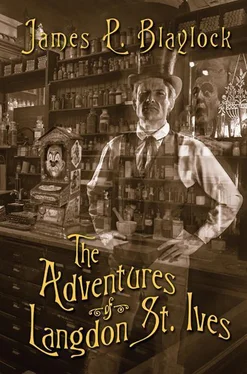We should have hired the dirigible in the first place, lamented St. Ives, standing on the platform in the cold arctic wind. We should have this, we should have that. I muttered and nodded, never having seen him in such despair. There was no arguing with him there in that rocky landscape, which did its part to freeze one’s hope. I would have to go on with as stout a heart as I could fabricate.
And so away they went south, and I north, and I didn’t learn another thing about their adventures until I met up with them again, days later, back in Sterne Bay, the dirigible rescue having come off without a hitch and skived at least a couple of days off my wanderings about Norway, but having sailed me into Dover too late to join my comrades in their dangerous scientific quest. I’m getting ahead of myself, though. It’s what I found out in Hjarmold, near the mountain, that signifies.
Narbondo had been fished out of his watery grave, all right — by a tall thin man with a baldhead. It had to have been Leopold Higgins, although he had registered at the hostel under the name Wiggins, which was evidence either of a man gone barmy or of a man remarkably sure of himself. I got all this from the stableboy, whose room lay at the back of the stables, and who had seen a good deal of what transpired there. No real effort had been made for secrecy. Higgins and an accomplice — Captain Bowker, from the description of him — had ridden in late one afternoon with Narbondo lying in the back of the wagon, stiff as a day-old fish. They claimed that he had just that morning fallen into the lake, that they had been on a climbing expedition. There was nothing in their story to excite suspicions. Higgins had professed to be a doctor and had stopped them from sending up to Bodø for the local medicine man.
Curiously, he hadn’t taken Narbondo inside the hostel to thaw him out; he had set up camp in the stables instead, insisting that Narbondo’s recovery must be a slow business indeed, and for the first two nights Narbondo slept on his table without so much as a blanket for covering. Higgins fed him nothing but what he said was cod-liver oil, but which he referred to as “elixir.” And once, when Narbondo began to moan and shudder, Higgins said that he was “coming round too soon,” and he hauled Narbondo out into the freezing night and let him stiffen up some.
The stableboy who told me all of this was a bright lad, who had smelled something rotten, as it were, and it wasn’t the fish oil, either. He had a sharp enough eye to recognize frauds like Higgins and Bowker, and he watched them, he said, through a knothole when they thought he was asleep. It was on the fourth night that Narbondo awakened fully, if only for a few seconds. Higgins had set up some sort of apparatus — hoses, bladders, bowls of yellow liquid. Throughout the night he had sprayed the doctor with mists while Captain Bowker snored in the hay. An hour before dawn, Narbondo’s eyes blinked open in the lamplight, and after a moment of looking around himself, puzzled at what he saw, he smiled a sort of half-grin and said the single word, “Good,” and then lapsed again into unconsciousness.
I knew by then what it was I had come for, and I had learned it in about half an hour. St. Ives had been right to turn around; it didn’t take three men to talk to a stableboy. After that I was forced to lounge about the village, eating vile food, wondering what it was that my companions were up to and when my dirigible would arrive, and worrying finally about one last bit of detail: the frozen man, according to my stableboy, had had milky-white hair and pale skin, like a man carved out of snow or dusted with frost; and yet Narbondo had had lanky black hair, just going to gray, when he had catapulted into that tarn.
The phrase “dusted with frost” wasn’t my own; it was the artful creation of my stableboy, who had lived for ten years in York and might have been a writer, I think, if he had put his mind to it. Here he was mucking out stables. It made me wonder about the nature of justice, but only for a moment. Almost at once it brought to mind the letter we had read in Godall’s shop, the one signed H. Frost, of Edinburgh University.
* * *
Meanwhile, Langdon St. Ives and Hasbro arrived back in Dover without incident — no bombs, no gunfire, no threats to the ship. I believe that our sudden disappearance from Sterne Bay had confounded our enemies. Perhaps they thought that the fruit-basket bomb had frightened us away, although Narbondo — or Frost — knowing St. Ives as well as he did, shouldn’t have made that mistake. Anyway, in Dover, St. Ives arranged for the dirigible to fetch me out of Norway, and then set about hiring a balloon for himself and Hasbro. They didn’t wait for me — they couldn’t — and I’m narrating their exploits as accurately as I can, having got the story secondhand, but straight from the horse’s mouth, of course.
St. Ives set about constructing a bismuth spiral, which, for the reader unfamiliar with the mysteries of magnetism, is a simple snail-shell spiral of bismuth connected to a meter that reads changes of resistance in the spiral to determine intensities of magnetic fields. It’s a child’s toy, comparatively speaking, but foolproof. The very simplicity of St. Ives’s notion infuriated him even further. It was something that ought to have been accomplished a week earlier, in time to save those ten men.
He affixed the spiral to a pole that they could slip down through a small hiatus in the basket of the balloon, so as to suspend the spiral just above the waves, making the whole business of taking a reading absolutely dangerous — almost deadly, as it turned out — because it required their navigating the balloon perilously close to the sea itself. Why didn’t they use a length of rope, instead — play out the line while staying safely aloft? That was my question too; and the answer, in short, is that the science of electricity and magnetism wouldn’t allow for it: the length of wire connecting the bismuth to the meter must be as short as possible for the reading to be accurate — that was how St. Ives understood it, although his understanding was nearly the death of him.
He meant to discover where Lord Kelvin’s machine — the enormously powerful electromagnet stolen from the machine works in Holborn — lay beneath the sea, somewhere in the Dover Strait. He assumed that it rested on a submerged platform or on a shallow sandy shoal. Maybe it was anchored, but then again maybe it was slowly drifting at the whim of deepwater currents. He suspected the existence of a float or buoy of some sort, both to locate it and, perhaps, to effect its switching on and off.
The two of them were aloft within a day. It was doubtful that the ban on local shipping would last out the week; the economy wouldn’t stand it. The government would pay the ransom or get used to the notion of losing ships. The Royal Academy still denied everything, right down to the ground, while at the same time working furiously to solve the mystery themselves.
St. Ives and Hasbro scoured the surface of the sea, from Ramsgate to Dungeness. Hasbro, an accomplished balloonist — the blue-ribbon winner, in fact, of the Trans-European balloon races of 1883 — grappled with the problem of buoyancy, of keeping the basket above the licking waves in order not to drown St. Ives’s apparatus. The wind blew down out of the North Sea in gusts, buffeting them southward toward the coast of France, and it took all of Hasbro’s skill to steady their course at all. St. Ives had fashioned a sort of ballasted sea anchor that they dragged along and so avoided being blown across the coast of Normandy before discovering anything.
Even so, it finally began to seem as if their efforts were in vain — the Strait being almost inconceivably vast from the perspective of two men in a balloon. It was sometime late in the afternoon, when they were just on the edge of giving up, that they saw a sloop flying the ensign of the Royal Academy. St. Ives could see Parsons on the deck, and he waved to the man, who, after seeming to ascertain who it was that hailed him, replied with a perfunctory little nod and went immediately belowdecks. There was the chance, of course, that the Academy had already discovered the spot where the device had been sunk. And there was the chance that they were still searching. What would St. Ives do? What could he do?
Читать дальше












